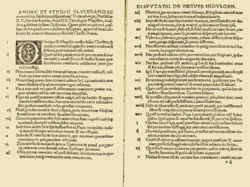| Part of a series on the |
| Reformation |
|---|
 |
| Protestantism |
The Magisterial Reformation includes the Lutheran, Reformed, and Anglican traditions of Protestant Christianity and how these denominations "related to secular authorities, such as princes, magistrates, or city councils", i.e. "the magistracy".[1][2] While the Radical Reformation (that led to the Anabaptist Churches) rejected any secular authority over the church,[3] the Magisterial Reformation argued for the interdependence of the church and secular authorities. As Alister McGrath put it "The magistrate had a right to authority within the church, just as the church could rely on the authority of the magistrate to enforce discipline, suppress heresy, or maintain order."[2]
The Protestant Reformation was a major movement in Western Christianity that, in 16th-century Europe, among other things, posed a religious and political challenge to the Catholic Church and to papal authority. The Reformation was the start of Protestantism and represented a split in the Western Church that produced multiple churches and denominations that had different ways of conducting Christian worship and Christian life relative to the Roman Church. The theological figures of the Reformation could be classified into Magisterial Reformers and Radical Reformers. Though the Catholic Church continued its claim to be the one true church, the churches that sprung out of the Magisterial Reformation denied the Church of Rome's exclusive claim to the title of "Catholic" and continue to claim that they are part of the continuation of the "Catholic Church" as it is referred to in the Nicene Creed.
In addition, the term magister relates to the emphasis on the authority of the church's teachers. The theological schools that are collectively known as Magisterial Protestants include the Lutheran, Reformed, and Anglican traditions of Christianity.[4][5]
The major reformers representing the Magisterial Reformation were Luther, Zwingli and Calvin,[6] John Knox,[7] as well as Thomas Cranmer. The Magisterial Reformers believed that secular authority should be followed, where it did not clash with biblical commands. An example of this was seen in the Peasant’s Rebellion of 1525 which Luther originally was sympathetic to, but later strongly condemned.[8][9]
- ^ Voorst, Robert E. Van (1 January 2014). Readings in Christianity. Cengage Learning. p. 164. ISBN 978-1-305-14304-3.
The Magisterial Reformation denotes the Lutheran, Calvinist, and Anglican churches; this is sometimes labeled the mainstream of the Reformation. Magisterial means that secular authorities ("magistrates") had a role in the life of the church; church and state were closely tied.
- ^ a b McGrath, Alister (1998), Historical Theology, Oxford: Blackwell Publishers, p. 159, ISBN 0-63120843-7
- ^ Saint-Clair, Geoffrey (2001), "Who's Who in the Reformation", The Radical Reformation, Catholic education, retrieved 2012-11-17
- ^ Shah, Timothy Samuel; Hertzke, Allen D. (26 April 2016). Christianity and Freedom: Volume 1, Historical Perspectives. Cambridge University Press. ISBN 978-1-316-55285-8.
... where nationally dominant magisterial Protestant churches (Lutheran, Anglican, and Presbyterian) became virtual "departments of state" in their governance, as one Reformation historian characterized them.
- ^ Cremeens, Timothy B. (28 June 2018). Marginalized Voices: A History of the Charismatic Movement in the Orthodox Church in North America 1972-1993. Wipf and Stock Publishers. p. 157. ISBN 978-1-5326-1708-9.
The "magisterial" Protestant denominations (i.e., Lutheran, Reformed, and Anglican) all claimed to honor the ecumenical Councils of the undivided Church and give a modicum of authority to the Church Fathers
- ^ The Gospel Coalition website
- ^ Cambridge University website
- ^ Bloomsbury website
- ^ Socialist Worker website